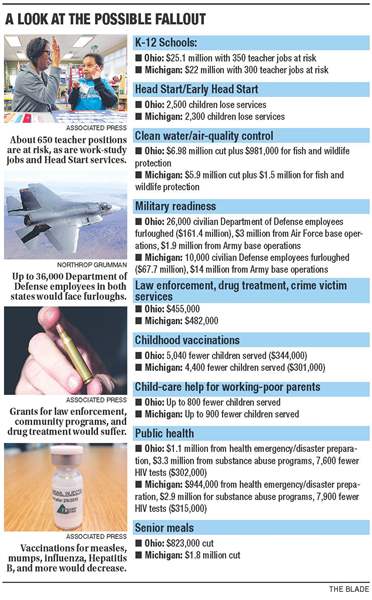
FEDERAL SEQUESTRATION CRISIS
Cuts’ impact on Ohio, Michigan to be wide, deep
Contingency plans few, officials say
2/26/2013

Homeland Security Secretary Janet Napolitano, accompanied by White House press secretary Jay Carney, briefs reporters on the sequester at the White House in Washington.

COLUMBUS — Local police, teachers, health clinics, and federal defense workers are bracing for the $85 billion federal budget ax they were once promised would never fall.
And there seem to be few contingency plans for, if and when, the cuts are implemented over a seven-month period beginning Friday. Local governments and K-12 schools that already have taken a hit in the current state budget hold little hope that Ohio will step forward now to fill part of the federal gap, even as the state talks about socking away as much as $1.9 billion into its rainy-day fund.
Find what the White House says the cuts will be, by state, from the automatic federal spending cuts to be imposed on Friday. Click on the links below:
1. Alabama
2. Alaska
3. Arizona
4. Arkansas
5. California
6. Colorado
7. Connecticut
8. Delaware
10. Florida
11. Georgia
12. Hawaii
13. Idaho
14. Illinois
15. Indiana
16. Iowa
17. Kansas
18. Kentucky
19. Louisiana
20. Maine
21. Maryland
22. Massachusetts
23. Michigan
24. Minnesota
25. Mississippi
26. Missouri
27. Montana
28. Nebraska
29. Nevada
30. New Hampshire
31. New Jersey
32. New Mexico
33. New York
34. North Carolina
35. North Dakota
36. Ohio
37. Oklahoma
38. Oregon
39. Pennsylvania
40. Rhode Island
41. South Carolina
42. South Dakota
43. Tennessee
44. Texas
45. Utah
46. Vermont
47. Virginia
48. Washington
49. West Virginia
50. Wisconsin
51. Wyoming
“[Cities have] already lost half of their [state] local government funds,” said Sue Cave, executive director of the Ohio Municipal League. “They have lost the phased-out tangible personal property tax replacement dollars. Starting this year, they’re losing estate tax money big time.
“There’s nothing out there to replace it except to go to the local voters to approve either income tax increases or property tax levies or to just cut the services altogether,” she said.
The finger-pointing continued Monday between the Democratic White House and congressional Republicans over the inability to negotiate alternatives to cuts affecting discretionary spending outside of programs such as Social Security.
The White House is working to ignite public outrage, citing the cuts’ potential effects on programs affecting the middle class.
In a phone call with reporters, Jason Furman, principal deputy director of the National Economic Council, cited the political battleground of Ohio. The cuts in K-12 education in the state could be about $25.1 million.
“In Ohio, 350 teachers and aide jobs would be at risk,” he said. “In Ohio, 34,000 fewer students would be served, and approximately 100 fewer schools would be served.”
Numbers released by the White House showed Michigan could lose $22 million with 300 educator jobs on the line.
Between the two states, some 36,000 civilian U.S. Department of Defense employees could be laid off, sucking $229 million in wages out of the economy.
Also anticipated are cuts to Head Start early learning, childhood vaccinations, senior meals, crime-victim services, child-care assistance for working-poor parents, and substance-abuse treatment.
These are in addition to broad cuts in federal agencies that could have a trickle-down effect on state and local governments. Some of the cuts could take weeks before they are felt, but others, such as a 10 percent reduction in long-term unemployment compensation checks, could sting right away.
Tim Keen, Ohio Gov. John Kasich’s budget director, again said that the uncertainty surrounding the potential cuts and the effects they could have on the national economy are reasons why the state should bank anticipated budget surpluses while it can.
Mr. Kasich plans to add an anticipated $1.4 billion surplus at the end of this fiscal year on June 30 to just under $500 million already in the rainy-day fund. This would trigger an automatic income tax rebate to Ohioans under state law totaling about $400 million that would show up when taxpayers file their 2013 returns in 2014.
State agencies themselves are not expected to take a major hit.
“Under the present plan, Medicaid and most transportation programs, two of the largest sources of federal funding in Ohio’s budget, are exempt from sequestration,” Mr. Keen said. “[The Office of Budget Management] is prepared to work with all state agencies to manage any other impacts the sequestration might create.
“However, it is our general sense that we will not see significant disruptions to state operations or federally funded programs,” he said.
Contact Jim Provance at: jprovance@theblade.com, or 614-221-0496.